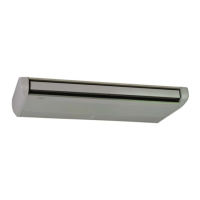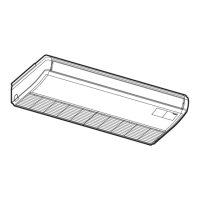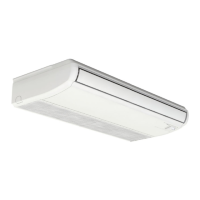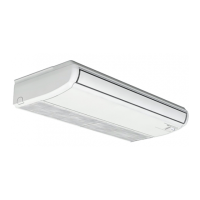Do you have a question about the Hitachi RPC-3.0FSNE and is the answer not in the manual?
Immediate hazards that WILL result in severe injury or death.
Hazards or unsafe practices that COULD result in severe personal injuries or death.
Hazards or unsafe practices that COULD result in minor personal injury or product damage.
Definitions for DANGER, WARNING, and CAUTION signal words.
Specifies the recommended temperature range for cooling and heating modes.
Information on the high-pressure vessel and safety device for preventing abnormal pressures.
Supply power 12 hours before start-up after shutdown to heat compressor oil.
RUN indicator blinks, 'ALARM' displayed with unit/alarm/model codes.
Stop operation if water leakage or smoke/white smoke occurs from the unit.
Checks for no operation, poor cooling/heating, and other common problems.
Data to provide to service contractor for diagnosis (Unit Model, Trouble Content, Alarm Code).
Diagram showing the refrigerant flow for a single indoor/outdoor unit system.
Diagram illustrating the refrigerant flow for a twin system with two indoor units.
Safety and environmental considerations for installing the outdoor unit.
Specifies required clearances for ceiling suspension and floor installation.
Guidelines for preparing installation sites, including foundations and suspension.
Guidelines for selecting and preparing copper pipes for refrigerant connections.
Table detailing required tightening torques for various pipe sizes and connections.
Charts and notes for designing refrigerant piping length based on height difference.
Use nitrogen gas for blowing during brazing to prevent explosion or poisonous gas.
Do not charge flammable or poisonous gases; use oxygen-free nitrogen for tests.
Ensure field-supplied electrical components comply with electrical data and codes.
Ensure secure ground wire connection and general electrical safety precautions.
Follow local codes, use twisted shielded pair wiring, and connect lines correctly to prevent PCB failure.
Checks before test run: electrical resistance, stop valves, power supply, and safety warnings.
Activating TEST RUN mode by pressing MODE and CHECK switches simultaneously.
Starting the test run operation and checking for abnormalities.
Diagnosing and resolving issues during test run, including lamp flickering and unit not starting.
Configuring DSW1 for test run, operation mode, and compressor control.
Details on internal thermostats, fuses, and freeze protection for indoor units.
Settings for high pressure switches, bypass switches, crankcase heater, and current sensors.
Indicates failure in transmission between indoor unit and remote control switch.
Table listing alarm codes, category, contents of abnormality, and leading causes.
Diagnosing and resolving issues when the unit operation indicator is not activated.
Resolving issues where compressor or fan motor does not activate.
Addressing flickering indicators or lamps, e.g., RUN switch, with potential causes and solutions.
Addressing compressor stopping or starting issues despite thermostat adjustments.
Resolving issues where outdoor fan motor and compressor do not restart after stopping.
Diagnosing and resolving issues causing insufficient cooling performance.
Diagnosing and resolving issues causing insufficient heating performance (Heat Pump Models).
Immediate hazards that WILL result in severe injury or death.
Hazards or unsafe practices that COULD result in severe personal injuries or death.
Hazards or unsafe practices that COULD result in minor personal injury or product damage.
Definitions for DANGER, WARNING, and CAUTION signal words.
Specifies the recommended temperature range for cooling and heating modes.
Information on the high-pressure vessel and safety device for preventing abnormal pressures.
Supply power 12 hours before start-up after shutdown to heat compressor oil.
RUN indicator blinks, 'ALARM' displayed with unit/alarm/model codes.
Stop operation if water leakage or smoke/white smoke occurs from the unit.
Checks for no operation, poor cooling/heating, and other common problems.
Data to provide to service contractor for diagnosis (Unit Model, Trouble Content, Alarm Code).
Diagram showing the refrigerant flow for a single indoor/outdoor unit system.
Diagram illustrating the refrigerant flow for a twin system with two indoor units.
Safety and environmental considerations for installing the outdoor unit.
Specifies required clearances for ceiling suspension and floor installation.
Guidelines for preparing installation sites, including foundations and suspension.
Guidelines for selecting and preparing copper pipes for refrigerant connections.
Table detailing required tightening torques for various pipe sizes and connections.
Charts and notes for designing refrigerant piping length based on height difference.
Use nitrogen gas for blowing during brazing to prevent explosion or poisonous gas.
Do not charge flammable or poisonous gases; use oxygen-free nitrogen for tests.
Ensure field-supplied electrical components comply with electrical data and codes.
Ensure secure ground wire connection and general electrical safety precautions.
Follow local codes, use twisted shielded pair wiring, and connect lines correctly to prevent PCB failure.
Checks before test run: electrical resistance, stop valves, power supply, and safety warnings.
Activating TEST RUN mode by pressing MODE and CHECK switches simultaneously.
Starting the test run operation and checking for abnormalities.
Diagnosing and resolving issues during test run, including lamp flickering and unit not starting.
Configuring DSW1 for test run, operation mode, and compressor control.
Details on internal thermostats, fuses, and freeze protection for indoor units.
Settings for high pressure switches, bypass switches, crankcase heater, and current sensors.
Indicates failure in transmission between indoor unit and remote control switch.
Table listing alarm codes, category, contents of abnormality, and leading causes.
Diagnosing and resolving issues when the unit operation indicator is not activated.
Resolving issues where compressor or fan motor does not activate.
Addressing flickering indicators or lamps, e.g., RUN switch, with potential causes and solutions.
Addressing compressor stopping or starting issues despite thermostat adjustments.
Resolving issues where outdoor fan motor and compressor do not restart after stopping.
Diagnosing and resolving issues causing insufficient cooling performance.
Diagnosing and resolving issues causing insufficient heating performance (Heat Pump Models).
| Cooling Capacity (kW) | 3.0 |
|---|---|
| Refrigerant | R410A |
| Type | Split |
| Heating Capacity | 3.2 kW |
| Power Supply | 220-240V, 50Hz |












